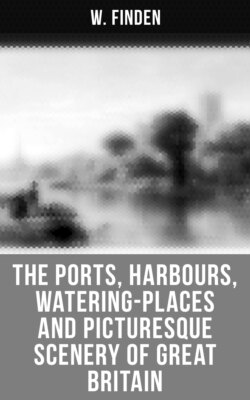Читать книгу The Ports, Harbours, Watering-places and Picturesque Scenery of Great Britain - W. Finden - Страница 33
На сайте Литреса книга снята с продажи.
BERWICK.
FROM THE SOUTH-EAST.
ОглавлениеTable of Contents
The view of Berwick from the south-east is taken from the Tweedmouth shore, at low-water, about a quarter of a mile below the bridge. In the foreground is a group of salmon-fishers on the shore examining the produce of their last haul, while two others in a coble are shooting the net. To the left are seen the chapel and some of the houses of Tweedmouth; to the right a few ships are perceived lying on the shore near Berwick quay, where the smacks usually take in, and discharge, their cargoes. The spire which towers above the houses, like the steeple of a church, is that of the town-hall. As Berwick church, which stands towards the north side of the town, is without a steeple, it would seem that the inhabitants had determined to make amends for the deficiency by giving their town-hall a steeple like a church.
The town of Berwick stands on the north side of the Tweed, by which it is separated from the county of Northumberland, and about half a mile from the mouth of that river. It is 336 miles north by west from London, and 54 south by east from Edinburgh. As a great part of the town is built on a declivity, which slopes down towards the river, and as most of the houses are covered with red tiles, the view that is first obtained of it, in approaching from the south, on a clear bright day, is very striking, though not very grand. It is almost the only town on the Scottish side of the Tweed in which the houses are so covered; in all the others the houses being, for the most part, roofed with slate.
Chalmers, in his Caledonia, vol. ii, p. 217, speaking of Berwick, says, "this place, lying at the mouth of the Tweed, on a dubious frontier, has an origin obscure, undignified, and recent." That its origin, like the origin of most other towns in Great Britain, is obscure, may be admitted; but the term "recent" can scarcely be applied with propriety to a town which was of such consequence in the reign of David I. as to be appointed one of the "Four Boroughs,"[10] which, by their Commissioners, met annually at Haddington, where, under the presidency of the King's Chamberlain, they formed a Court of Appeal from the jurisdiction of other boroughs, and exercised an authority in commercial affairs. As nothing is positively known respecting the origin of Berwick, it is impossible that an uninspired antiquary should be able to decide whether it was "undignified" or not. Its first "kirk and mill"—the primary conditions of a town—were more likely to be founded by a noble than by a serf.
In 1174, Berwick, with the castles of Jedburgh, Roxburgh, Stirling, and Edinburgh, was delivered up to Henry II. as security for payment of the ransom of William the Lion, King of Scotland, who had been taken prisoner when besieging Alnwick; and it remained in the possession of England until 1189, when Richard I. restored it with the other castles to William for the sum of 10,000 marks. In 1216, Berwick was plundered and burnt by King John, but in a short time was rebuilt by the Scots, in whose uninterrupted possession it continued until 1296, when it was taken by Edward I. at the commencement of the Scottish war of independence, which was first waged by Wallace, and afterwards by Bruce, against Edward and his successor; who, laying claim to the sovereignty of Scotland, endeavoured to reduce that country to a state of vassalage, and to compel her kings to do homage to England for their crown. From this war may be dated that jealous and hostile feeling with which the two countries continued to regard each other for nearly three centuries afterwards, and was only modified in the reign of Elizabeth—when there was a prospect of a Scottish king succeeding to the English throne, and when open warfare was succeeded by political intrigue—but which was not wholly extinct at the Union of the two kingdoms in 1707.
In 1484, it was agreed on, by commissioners appointed by the two kingdoms, that the debatable ground in the neighbourhood of Berwick should remain without culture, buildings, or inhabitants; and by a treaty, concluded at Norham, 10th June, 1551, between Edward VI. and Mary Queen of Scots, Berwick was declared to be a free town, independent of both kingdoms. Notwithstanding this declaration, Berwick continued subject to English authority, and, during the reigns of Mary and Elizabeth, was garrisoned with English soldiers. At the Union of the two kingdoms in 1707, Berwick, as a salvo to national pride, was considered as a separate and independent territory; and it is to this cause that, in Public Acts and Forms of Prayer, the "Town of Berwick-upon-Tweed" is especially mentioned.
LEITH PIER AND HARBOUR.
